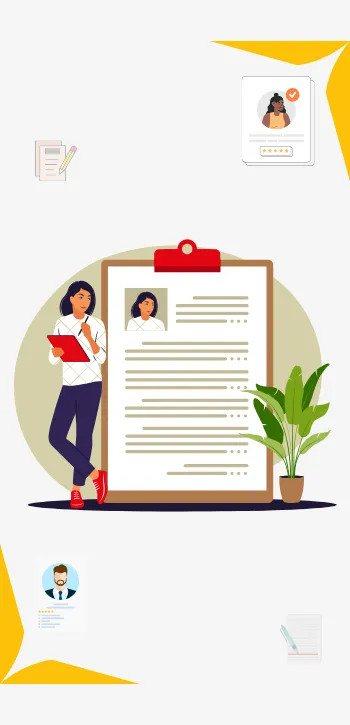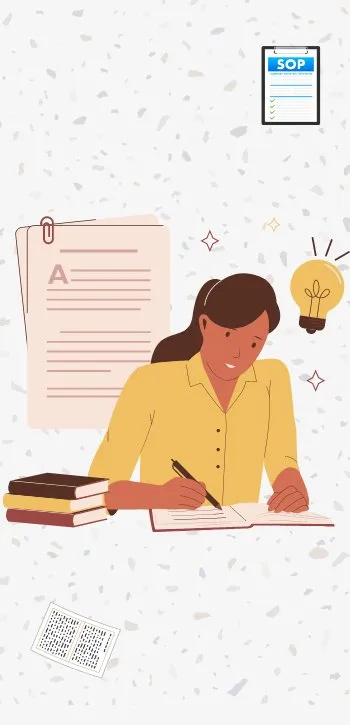- The UK is transitioning from the Biometric Residence Permit (BRP) to the new eVisa system for international students.
- The eVisa will be accessible online through your UKVI account, where you can view and manage your visa status.
- If you currently hold a BRP, you will need to transition to the eVisa system before 31 December 2024. UKVI will guide you through the process of switching to the new digital system.
- What Was the Biometric Residence Permit (BRP)?
- Why is the BRP Being Replaced?
- From Biometric Residence Permit (BRP) to eVisa
- What is an eVisa and How Does it Work for Students?
- How to Apply for a UK Student Visa Under the New eVisa System?
- Benefits of the UK eVisa for International Students
- Key Differences Between the Biometric Residence Permit (BRP) and the eVisa
- How to Transition from BRP to eVisa as an International Student?
- Using the eVisa in Everyday Student Life
- Key Takeaways by AdmitX
- FAQs
For international students planning to study in the UK, understanding visa requirements and staying legally compliant are crucial. One of the key documents for foreign nationals in the past was the biometric residence permit (BRP). However, recent changes in UK immigration law have replaced the traditional BRP with the eVisa.
In this blog, we will dive into the details of the biometric residence permit, its role for international students, the transition to the eVisa, and how students can navigate these changes.
What Was the Biometric Residence Permit (BRP)?
The biometric residence permit (BRP) was a physical card issued to foreign nationals, including students, who were granted leave to remain in the UK. The BRP included biometric data such as fingerprints and a facial image. It also contained vital information about the individual’s immigration status, visa type, and specific conditions regarding their stay in the UK.
For international students, the BRP served as proof of their legal right to stay in the UK for the duration of their course. Upon arrival, students were required to collect their BRP or have it mailed to their UK address, depending on the application procedure. This physical document was necessary for a variety of tasks, such as registering with the NHS, opening a UK bank account, and providing proof of status to potential employers.
Why is the BRP Being Replaced?
The UK government announced its plan to modernise its immigration system by transitioning from physical permits to digital records. There are several reasons behind this change.
- To make the visa process more secure and reduce fraud or identity theft
- To avoid the risks of lost or damaged physical cards
- To offer easier and faster access to immigration details
- To allow real-time updates to visa information without needing a new card
- To align with global trends in digital border management and ID systems
The BRP phase-out is part of a larger government initiative to build a fully digital immigration environment by the end of 2024. From that point onwards, everyone will be required to use their eVisa to prove their right to live, study, or work in the UK.
From Biometric Residence Permit (BRP) to eVisa
To streamline the immigration process and modernise the UK’s visa system, the UK Home Office has decided to replace the biometric residence permit (BRP) with the eVisa for most foreign nationals, including students. The eVisa is a digital visa that stores all the relevant information about your visa status electronically, making it more accessible, secure, and convenient for international students.
The transition to the eVisa aims to reduce the burden of managing physical documents and offer a more efficient system that can be accessed online. The eVisa provides the same level of information as the BRP, including the student’s name, visa conditions, and biometric data, but now, everything is stored digitally rather than on a physical card.
What is an eVisa and How Does it Work for Students?
The eVisa is a fully electronic version of a UK visa, designed to replace traditional paper documents and biometric cards. For Indian students, this means that instead of waiting for a physical biometric residence permit (BRP), they will now access an eVisa, which includes all the necessary details about their immigration status in one digital format.
Here’s a step-by-step overview of how the eVisa works for international students
Application Process
The process for applying for a eVisa remains largely the same. Students must submit their visa application through the UK Visas and Immigration (UKVI) website, where biometric data (fingerprints and facial image) will still be collected as part of the application process. This data will be stored electronically and used to verify your identity once you are granted the visa.
Receiving the eVisa
Once your visa application is approved, you will receive an electronic visa confirmation, which can be accessed via a secure online platform. Unlike the BRP, there is no physical card that you need to collect. The eVisa serves as your proof of legal status in the UK.
How to Access Your eVisa
You can view and manage your eVisa details online. The online platform will include essential information such as your visa type, duration, and any specific conditions that apply to your stay in the UK, including your ability to work or access public services. Accessing your eVisa is simple: you can log in to the online portal where your visa status is stored and check or update your details as necessary.
Travelling to the UK
When you travel to the UK, you won’t need to present a biometric residence permit (BRP) to border control. Immigration officers will verify your status electronically using the eVisa system, making entry smoother and faster.
Using the eVisa for Other Services
Once in the UK, the eVisa will be used for accessing essential services such as registering with the NHS, opening a bank account, and proving your immigration status to potential employers. The UK authorities can verify your status directly through the eVisa system, making the process faster and more secure.
How to Apply for a UK Student Visa Under the New eVisa System?
The process of applying for a UK student visa remains mostly the same, with a few adjustments to support the digital update. Here is how it works:
- You first complete the online visa application through the official UKVI portal
- You attend a biometric appointment where your photograph and fingerprints are recorded
- After your visa is approved, instead of a BRP, you are issued an eVisa linked to your passport
- You receive login details to your UKVI account to view and manage your visa status.
Benefits of the UK eVisa for International Students
The eVisa brings numerous benefits to international students who are planning to study in the UK. These include:
Simplified Process: The eVisa eliminates the need for physical card collection and reduces the paperwork involved in visa management.
Instant Access to Visa Details: Students can access their UK eVisa details from any device with internet access, making it convenient and accessible.
Improved Security: As an entirely digital system, the eVisa is more secure than traditional paper documents and offers better protection against fraud.
Faster Immigration Process: Border officials and service providers can verify your immigration status more quickly through the UK eVisa system, speeding up the overall process.
Key Differences Between the Biometric Residence Permit (BRP) and the eVisa
The introduction of the eVisa brings several key differences compared to the traditional biometric residence permit (BRP), which are designed to simplify the experience for international students:
No Need for Physical Documents
One of the most significant changes is that students will no longer need to collect a physical biometric residence permit (BRP) after arriving in the UK. Instead, all relevant visa information is stored digitally, accessible online. This reduces delays and eliminates the need to carry around a physical card.
Enhanced Security and Convenience
The eVisa system offers enhanced security features, reducing the risk of identity fraud and document forgery. Since your visa information is stored securely in an online system, it is easier to track and manage your visa status. You can also easily update your details if needed, such as extending your visa or changing your visa conditions.
Efficient Access to Services
With the eVisa, you can instantly access your visa details through a secure online platform, streamlining the process for various tasks like opening a bank account or registering for healthcare services. All relevant authorities will be able to verify your status digitally, cutting down on waiting times and reducing paperwork.
How to Transition from BRP to eVisa as an International Student?
If you are in the process of applying for a UK study visa, it’s important to know that the biometric residence permit (BRP) will soon be phased out for most students, and you will be issued an eVisa instead. Here’s how to navigate this change:
Check the UKVI Website: Always refer to the official UK Visas and Immigration (UKVI) website for the most up-to-date information about your visa application and the transition to the eVisa system.
Keep Your Digital Records Safe: As the eVisa is a digital document, ensure you save all the relevant information and store it securely on your devices. You will need access to this information when proving your immigration status in the UK.
Stay Informed: If you have questions or concerns about how this transition affects your application or arrival process, stay in touch with UK immigration services or consult with your university’s international office for guidance.
Using the eVisa in Everyday Student Life
You will need to use your eVisa regularly during your stay in the UK. Here’s how it supports your life as a student
Registering with the NHS: Your visa allows access to public health services
Opening a bank account: Banks will request your visa status, which you can provide via a share code.
Renting accommodation: Landlords may verify your right to rent through your digital status.
Working part-time: Employers must confirm your right to work, which you can prove through your eVisa
Travelling abroad: Border officials can access your status electronically at airports
Key Takeaways by AdmitX
The UK is phasing out the Biometric Residence Permit (BRP) and transitioning to a digital eVisa system for international students, including those from India. With this shift, students no longer need to collect a physical BRP upon arrival in the UK. Instead, the eVisa will serve as the official proof of immigration status, which can be accessed through a UKVI account.
The eVisa system allows students to view and share their visa status digitally, generating share codes for employment, accommodation, and other legal processes. This change eliminates the risk of losing or damaging a physical card and ensures real-time updates to visa information, making it a more secure and convenient option.
FAQs
What is the difference between the Biometric Residence Permit (BRP) and the eVisa?
The Biometric Residence Permit (BRP) is a physical card issued to international students in the UK, while the eVisa is a digital record that stores all your visa information. The eVisa is replacing the BRP as part of the UK’s move towards a digital immigration system.
Do I still need to provide biometric data for my visa?
Yes, you will still need to provide biometric data, including fingerprints and a photograph, during the visa application process. This information is used to issue your eVisa.
How do I prove my immigration status in the UK now that the BRP is being replaced?
You can prove your immigration status by logging into your UKVI account and generating a share code. This code can be shared with employers, landlords, or other institutions to verify your visa status.
Will I need a BRP if I’m already in the UK with a valid visa?
No, the BRP is being replaced by the eVisa. If you currently hold a BRP, you will be required to transition to the eVisa system before 31 December 2024.
What should I do if I lose access to my UKVI account or forget my login details?
If you lose access to your UKVI account, use the account recovery options available on the UKVI website.
You will be able to recover your account by verifying your identity with personal details, such as your passport number.














